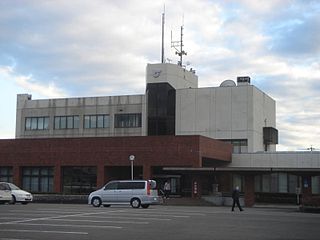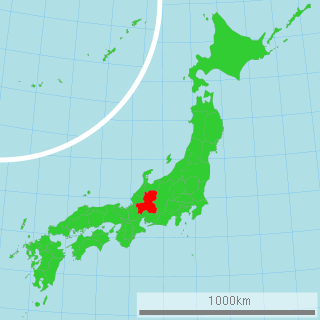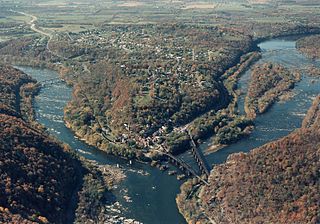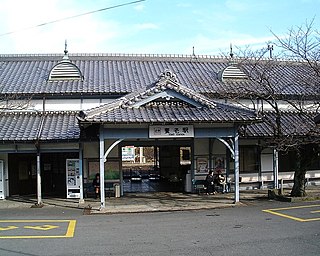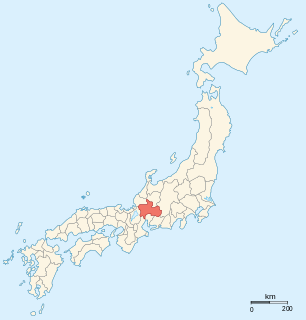
Mino Province, one of the old provinces of Japan, encompassed the southern part of modern-day Gifu Prefecture. It was sometimes called Nōshū (濃州). Mino Province bordered Echizen, Hida, Ise, Mikawa, Ōmi, Owari, and Shinano Provinces.

Ibigawa is a town located in Ibi District, Gifu Prefecture, Japan. As of 1 December 2018, the town had an estimated population of 21,319 in 8,015 households and a population density of 27 persons per km2, in 8,032 households. The total area of the town was 803.44 square kilometres (310.21 sq mi).

Ikeda is a town located in Ibi District, Gifu Prefecture, Japan. As of 1 December 2018, the town had an estimated population of 24,034 in 8291 households and a population density of 620 persons per km2. The total area of the town was 38.80 square kilometres (14.98 sq mi).

Mount Ibuki is a 1,377-metre-high (4,518 ft) mountain, on the border of Maibara, Shiga Prefecture, and Ibigawa, Gifu Prefecture, Japan. It is one of the 100 Famous Japanese Mountains, and is also included on the lists of the 100 Kinki Mountains and the 50 Shiga Mountains. Mount Ibuki is the highest mountain in Shiga Prefecture.

Hakusan National Park is a national park in the Chūbu region of Honshū, Japan. Established in 1962, it spans the borders of Fukui, Gifu, Ishikawa, and Toyama prefectures. Its main geographical feature is Mount Haku. In 1980 an area of 480 km² corresponding to the national park was designated a UNESCO Man and the Biosphere Reserve.

Mount Hotaka, also known as Mount Hotakadake, is one of the 100 Famous Japanese Mountains as coined by the media, reaching a height of 3,190 m (10,466 ft). Mount Hotaka is situated in Japan's Hida Mountains and all its major peaks except Mount Maehotaka, lie on the border between the cities of Matsumoto, Nagano Prefecture, and Takayama, Gifu Prefecture. This mountain is located in Chūbu-Sangaku National Park.

The Nōbi Plain is a large plain in Japan that stretches from the Mino area of southwest Gifu Prefecture to the Owari area of northwest Aichi Prefecture, covering an area of approximately 1,800 square kilometres (695 sq mi). It is an alluvial plain created by the Kiso Three Rivers and has very fertile soil. It is bordered on the west by the Ibuki and Yōrō mountain ranges, and to the east by the Owari Hills. Its northern border is marked by the Ryōhaku Mountains and the south by Ise Bay.

Matsuo Pond is a pond in Gifu, Gifu Prefecture, Japan. It is located at the southern base of Mount Dodo, the city's tallest mountain. The area around the lake is known as the Hagi Falls Nature Park. The park is very popular in the fall when the leaves are changing color.

The Yōrō Mountains are a mountain range straddling the border between Gifu and Mie prefectures in Japan. They form part of the western border of the Nōbi Plain.

The Hagi Falls is a waterfall located in Mount Dodo's small valley in the city of Gifu, Gifu Prefecture, Japan. In 1986, it was named one of Gifu Prefecture's "50 Famous Waters."

Mount Kanmuri is a mountain located on the border between Gifu and Fukui prefectures in the Chūbu region of Japan. It is 1,256.6 m (4,123 ft) tall and part of the Ryōhaku Mountains. It is also the source of the Ibi River.

Mount Ikeda is a mountain located in the towns of Ikeda and Ibigawa, in Ibi District, Gifu Prefecture, Japan.

Hayato Great Falls is a waterfall on the Hayato River within the boundaries of the Tanzawa-Ōyama Quasi-National Park, in Sagamihara, Kanagawa Prefecture, Japan.
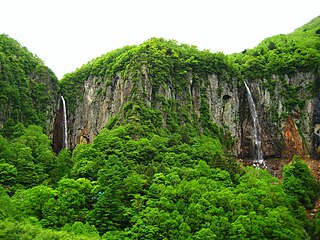
Yonako Falls, literally "Yonako Large Waterfalls" ) is a waterfall located in Yonako, Suzaka City, Nagano Prefecture, in the central part of Japan.

Kuji River is a river in Fukushima Prefecture, Tochigi Prefecture and Ibaraki Prefecture, Japan. It rises at the northern slope of Mount Yamizo, where the border of these three prefectures is located, and flows into Pacific Ocean at Hitachi and Tokai in Ibaraki Prefecture. It has a length of 124 kilometers (77 mi) and a drainage area of 1,490 square kilometers (580 sq mi), and is designated as a Class A river.
